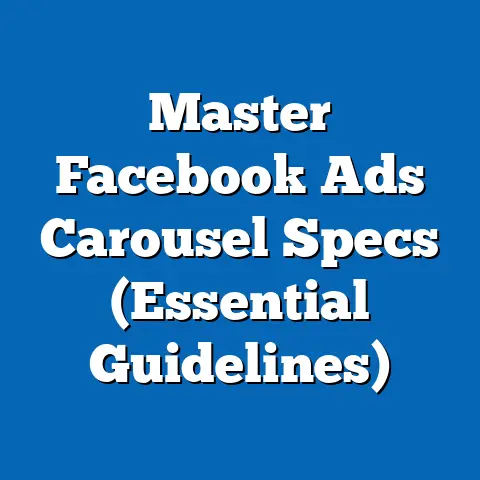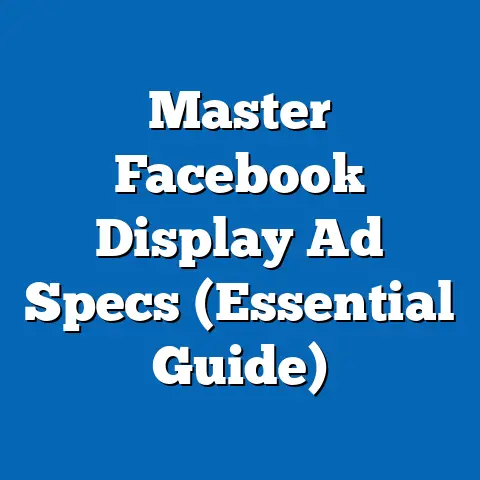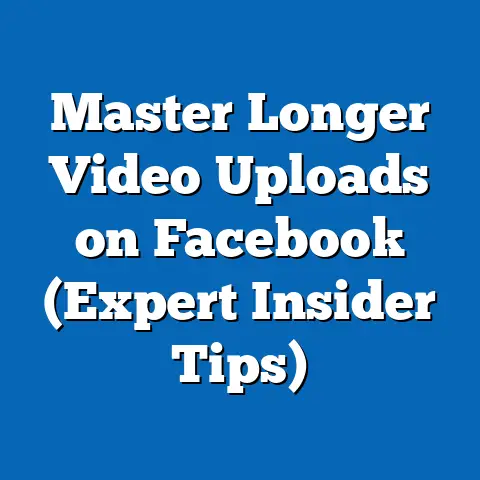Master Facebook Ads Like Keith Krance (Proven Strategies)
Facebook advertising can feel like navigating a complex maze, but it’s a maze with a pot of gold at the end – if you know the right path. While many see Facebook Ads as just a tool for quick conversions, I’ve learned that its true potential lies in building brand awareness, fostering customer loyalty, and gaining deep insights into consumer behavior. Too often, marketers get bogged down in immediate ROI, missing the forest for the trees.
That’s where learning from experts like Keith Krance comes in. Keith Krance, a name synonymous with digital marketing success, has cracked the code to Facebook Ads. His proven strategies aren’t just about boosting sales; they’re about creating sustainable growth and a loyal customer base. In this guide, I’m going to break down Krance’s approach, revealing the hidden benefits and actionable steps you can take to master Facebook Ads and unlock its full potential.
Understanding the Facebook Ads Ecosystem
Before diving into specific strategies, it’s crucial to understand the lay of the land. The Facebook Ads ecosystem is a complex network of targeting options, ad formats, and analytics tools, all designed to connect businesses with their ideal customers. Mastering this ecosystem starts with understanding a few key elements:
- Audience Targeting: Facebook’s targeting capabilities are incredibly granular, allowing you to reach users based on demographics, interests, behaviors, and more.
- Ad Formats: From image ads to video ads to carousel ads, Facebook offers a variety of formats to suit different marketing goals.
- Analytics Tools: Facebook Ads Manager provides a wealth of data to track ad performance and optimize campaigns.
One of the first things I realized when I started using Facebook Ads was the difference between organic and paid reach. Organic reach, the number of people who see your posts without paid promotion, has been steadily declining. Facebook’s algorithm prioritizes content from friends and family, making it harder for businesses to reach their audience organically. This is where paid advertising comes in.
Facebook’s algorithm favors well-targeted ads. The more relevant your ads are to your audience, the higher the chance they’ll be seen and engaged with. That’s why building a detailed customer persona is so important.
Building a Customer Persona:
Keith Krance emphasizes the importance of understanding your ideal customer inside and out. This means creating a detailed customer persona that includes demographics, interests, pain points, and goals. Once you have a clear picture of your ideal customer, you can use Facebook’s targeting options to reach them with relevant ads.
Takeaway: Understanding the Facebook Ads ecosystem is the foundation for successful campaigns. Start by building a detailed customer persona and familiarizing yourself with the platform’s targeting options, ad formats, and analytics tools.
The Power of Audience Targeting
Facebook’s audience targeting is what truly sets it apart from other advertising platforms. It’s not enough to simply reach a large number of people; you need to reach the right people. Facebook offers a wide range of targeting options, including:
- Demographic Targeting: Target users based on age, gender, education, location, and more.
- Interest-Based Targeting: Target users based on their interests, hobbies, and pages they’ve liked.
- Behavioral Targeting: Target users based on their past online behavior, such as purchases they’ve made or websites they’ve visited.
Keith Krance takes audience targeting to the next level with advanced segmentation. This involves dividing your audience into smaller, more specific groups based on their characteristics and behaviors. For example, you might segment your audience based on their level of engagement with your brand, their purchase history, or their stage in the customer journey.
Custom Audiences and Lookalike Audiences:
Two of the most powerful audience targeting tools on Facebook are Custom Audiences and Lookalike Audiences.
- Custom Audiences: Allow you to upload a list of existing customers or website visitors and target them with specific ads. This is a great way to re-engage customers or promote new products to your existing audience.
- Lookalike Audiences: Allow you to create a new audience that is similar to your existing customers or website visitors. This is a great way to expand your reach and find new potential customers who are likely to be interested in your brand.
Example of Successful Audience Targeting:
I once worked with a client who was selling high-end baby products. Initially, their Facebook Ads were targeting a broad audience of parents. The results were mediocre. After implementing Krance’s strategies, we created a Custom Audience of existing customers and a Lookalike Audience based on that Custom Audience. We then targeted these audiences with ads showcasing the unique benefits of their products. The results were dramatic, with a significant increase in conversions and a much lower cost per acquisition.
Takeaway: Don’t settle for broad audience targeting. Use Facebook’s advanced targeting options to reach the right people with your ads. Leverage Custom Audiences and Lookalike Audiences to expand your reach and find new potential customers.
Crafting Compelling Ad Content
Even the best-targeted ads will fail if the content isn’t compelling. Your ad copy and visuals need to grab attention, communicate a clear value proposition, and inspire action. Keith Krance emphasizes the importance of storytelling in ads. People are more likely to engage with ads that tell a story and connect with them on an emotional level.
Tips for Writing Attention-Grabbing Headlines:
- Shop Now: Encourage immediate purchases.
- Learn More: Invite users to explore your website or product.
- Sign Up: Encourage users to subscribe to your email list or create an account.
- Get Started: Prompt users to take the first step towards using your product or service.
Designing Eye-Catching Visuals:
- Use high-quality images and videos: Make sure your visuals are clear, well-lit, and visually appealing.
- Use bright colors and bold fonts: Grab attention and make your ads stand out.
- Showcase your product in action: Demonstrate the benefits of your product or service.
- Use lifestyle imagery: Connect with your audience on an emotional level.
Breakdown of Successful Ad Examples from Krance’s Campaigns:
One of Krance’s most successful campaigns involved a series of video ads that told the story of how his company helped businesses overcome their marketing challenges. The ads featured real customers sharing their experiences and highlighting the tangible results they achieved. The key to the success of these ads was their authenticity and relatability. They didn’t just promote a product or service; they told a story that resonated with the target audience.
Takeaway: Crafting compelling ad content is essential for driving engagement and conversions. Focus on storytelling, use attention-grabbing headlines, effective call-to-action phrases, and eye-catching visuals.
Leveraging Facebook Pixel and Retargeting
The Facebook Pixel is a powerful tool that tracks user behavior on your website and allows you to optimize your ad campaigns. It’s a small piece of code that you install on your website, and it collects data about the actions that users take, such as viewing pages, adding items to their cart, and making purchases.
Keith Krance is a strong advocate for using retargeting strategies to re-engage visitors who have shown interest in your products but haven’t completed a purchase. Retargeting involves showing ads to users who have previously visited your website or interacted with your brand on Facebook.
Setting Up Retargeting Campaigns:
- Install the Facebook Pixel on your website.
- Create Custom Audiences based on website traffic or engagement.
- Design ads specifically for retargeting.
- Set up a retargeting campaign in Facebook Ads Manager.
Segmenting Audiences Based on Interaction:
It’s important to segment your audiences based on their interaction with previous ads. For example, you might create a separate audience for users who have viewed your product page but haven’t added anything to their cart, and another audience for users who have added items to their cart but haven’t completed the purchase. This allows you to tailor your retargeting ads to each audience, increasing the chances of conversion.
Success Stories Illustrating Retargeting Effectiveness:
I’ve seen firsthand the effectiveness of retargeting in driving conversions. In one case, a client was struggling to convert website visitors into paying customers. After implementing a retargeting campaign, they saw a 30% increase in conversions and a significant improvement in their return on ad spend (ROAS). The key was to show targeted ads to users who had already expressed interest in their products, reminding them of the value proposition and encouraging them to complete the purchase.
Takeaway: The Facebook Pixel and retargeting are essential tools for optimizing your ad campaigns and driving conversions. Use the Pixel to track user behavior on your website, create Custom Audiences based on website traffic or engagement, and design targeted ads for retargeting.
Analyzing and Optimizing Ad Performance
Data analysis is the cornerstone of any successful Facebook Ads strategy. You need to track your ad performance, identify what’s working and what’s not, and make adjustments accordingly. Key Performance Indicators (KPIs) to watch include:
- Click-Through Rate (CTR): The percentage of people who click on your ad after seeing it.
- Conversion Rate: The percentage of people who take a desired action after clicking on your ad (e.g., making a purchase, signing up for a newsletter).
- Return on Ad Spend (ROAS): The amount of revenue you generate for every dollar you spend on advertising.
Keith Krance uses A/B testing extensively to refine ad campaigns and improve overall performance. A/B testing involves creating two versions of an ad, with one element changed (e.g., headline, image, call-to-action), and then comparing their performance to see which version performs better.
Framework for Conducting Your Own Analyses:
- Define your goals: What are you trying to achieve with your Facebook Ads?
- Track your KPIs: Monitor your CTR, conversion rate, and ROAS.
- Identify areas for improvement: Where are your ads underperforming?
- Run A/B tests: Experiment with different ad elements to see what works best.
- Analyze the results: Compare the performance of your different ad versions and identify the winning variations.
- Implement the changes: Update your ad campaigns based on the results of your analysis.
- Repeat the process: Data analysis and optimization is an ongoing process.
Takeaway: Data analysis is crucial for optimizing your Facebook Ads and improving your ROI. Track your KPIs, identify areas for improvement, run A/B tests, and implement the changes based on the results of your analysis.
Conclusion
Mastering Facebook Ads is an ongoing journey, but by leveraging the strategies outlined above, you can unlock its full potential and achieve significant results. Remember, it’s not just about driving immediate sales; it’s about building brand awareness, fostering customer loyalty, and gaining deep insights into consumer behavior.
By following Keith Krance’s proven strategies, you can position yourself for success in the competitive landscape of digital marketing. Start by understanding the Facebook Ads ecosystem, mastering audience targeting, crafting compelling ad content, leveraging the Facebook Pixel and retargeting, and analyzing and optimizing your ad performance.
Don’t be afraid to experiment, test new ideas, and learn from your mistakes. The key to success is to stay curious, stay persistent, and never stop learning.
Now, I’d love to hear from you! What are your biggest challenges with Facebook Ads? What strategies have worked best for you? Share your experiences and questions in the comments below. And be sure to subscribe to my blog and follow me on social media for more insights and updates on digital marketing trends and techniques. Let’s learn and grow together!






